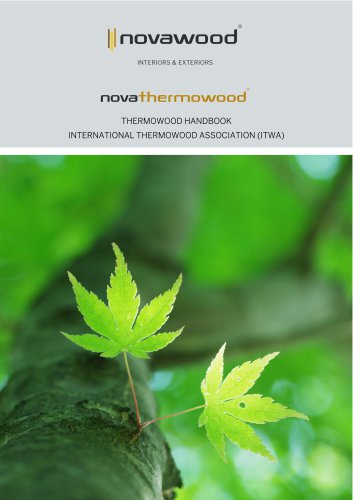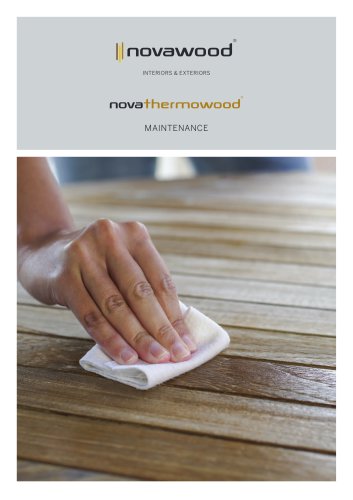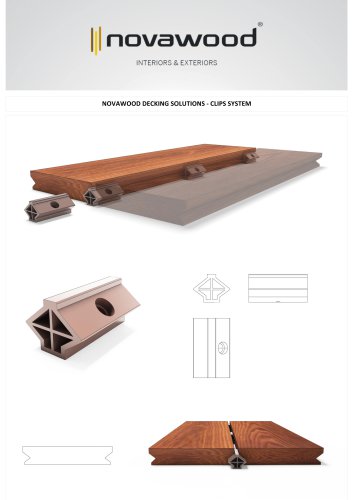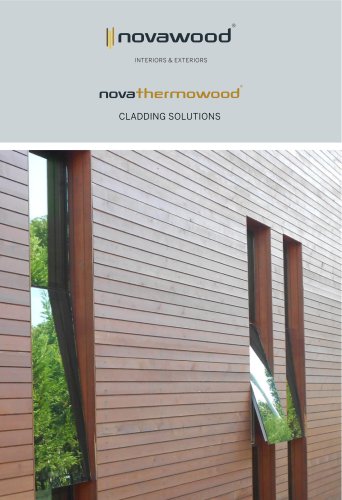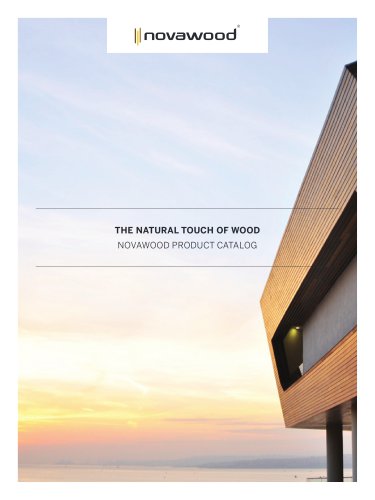 Website:
novawood
Website:
novawood
Catalog excerpts
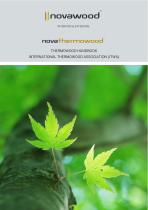
nova wood INTERIORS & EXTERIORS THERMOWOOD HANDBOOK INTERNATIONAL THERMOWOOD ASSOCIATION (ITWA)
Open the catalog to page 1
Preface This handbook has been produced by the members of the International Thermowood Association. When new products and methods of production enter the various markets, it is very important to offer as much information as possible concerning the product and process so as to raise and maintain the level of knowledge as efficiently as possible. Therefore, we hope that this handbook will act as a good information source for specifiers, end users in industry, construction companies, timber merchants, etc. The aim of the handbook is to present a good mix between theoretical material,...
Open the catalog to page 2
CHAPTER 0. Cover page ... 1 - 0 1.2. The ThermoWood® process in brief .1-1 1.3. Changes in wood structure and chemical reactions .3-1 1.4. Standard ThermoWood® treatment classification .. 4 -1 2.1. Factors affecting the quality of heat-treated wood .1-2 2.2. Sawn timber quality .1-2 2.2.1. General Nordic Softwood timber quality 2.2.3. Minimum requirements for raw material 2-2 CHAPTER 3. ThermoWood® process ... 1 - 3 CHAPTER 4. ThermoWood® properties . ..1-4 4.2.4. Equilibrium moisture content 10-4 4.2.5. Swelling and shrinkage due to moisture. 11-4
Open the catalog to page 3
CHAPTER 5. Working with ThermoWood® in industrial plants .1-5 5.6. Industrial gluing and jointing 3-5 5.7. Industrial surface treatment ...6 - 5 5.9. Practical experiences from a Finnish 6.5. ThermoWood® in sauna benches .4-6 CHAPTER 7. Handling and storage of ThermoWood® ..1-7 7.2. Handling of residual and discarded products 1-7 CHAPTER 8.Frequently asked questions and answers . ... 1 - 8
Open the catalog to page 4
1. Introduction 1.1. Background It has been known for centuries that burning the surface of wood in open fire will make it more durable in exterior use. Even the Vikings used this method in outdoor structures such as fences. Heat treatment of wood was scientifically studied by Stamm and Hansen in the 1930s in Germany and by White in the 1940s in the United States. In the 1950s, Germans Bavendam, Runkel, and Buro continued research into the subject. Kollman and Schneider published their findings in the 1960s, and Rusche and Burmester in the 1970’s. More recently, research work was carried...
Open the catalog to page 5
ThermoWood® process Figure 1-1. Diagram of the production process When the temperature is raised or lowered, a special adjustment system is used in order to prevent surface and inside splitting and checking. Customised adjustment values are used for different wood species and dimensions. The raw material can be green or kiln-dried wood. If the process is begun with green wood, the wood can be dried in a very fast high-temperature drying process. The method is suitable for softwood and hardwood species. However, the process must be optimised separately for each wood species. For more...
Open the catalog to page 6
1.3. Changes in wood structure and chemical reactions As a result of the heat treatment process the wood structure is re-formed, the following pictures show how the structure differs between normal untreated pine and heat treated pine. Figure 2-1. Untreated pine Figure 3-1. Heat-treated pine Heating wood permanently changes several of its chemical and physical properties. The change in properties is mainly caused by thermic degrading of hemicelluloses. Desired changes start to appear already at about 150 ºC, and the changes continue as the temperature is increased in stages. As a result,...
Open the catalog to page 7
1.4. Standard ThermoWood treatment classification Softwood and hardwood species have a separate classification since their properties clearly differ. There are two classes of heat treatment. Having more than two classes is not reasonable since wood properties change slowly at first as the temperature increases. Once the treatment temperature exceeds 200 oC, the properties change rapidly. Using more than two classes would generate a risk of mixing properties of different classes. 215 oC is sufficient as a maximum temperature value yet is not so high that the effects of heat treatment on the...
Open the catalog to page 8
Recommended end use applications for Thermo-D class heat-treated timber: Thermo-D Softwood - cladding - outer doors - shutters - environmental constructions - sauna and bathroom furnishing - flooring - garden furniture Thermo-D Hardwood End use applications as in Thermo-S. If a darker colour is desired, Thermo-D should be used. Summary of the effects of the ThermoWood process on wood properties, by treatment class Softwoods (pine and spruce) Thermo-S Treatment temperature Weather resistance Dimensional stability Bending strength Colour darkness Hardwoods (birch and aspen) Thermo-S Treatment...
Open the catalog to page 9
Wood preservatives. Determination of the protective effectiveness against Lyctus Brunneus (Stephens). Part 1: Application by surface treatment (laboratory method) Wood preservatives. Determination of the toxic values against Anobium punctatum (De Geer) by larval transfer (Laboratory method) Wood preservatives. Determination of the preventive action against recently hatched larvae of Hylotrupes bajulus (Linnaeus) (Laboratory method) Wood preservatives. Determination of the toxic values against Hylotrupes bajulus (Linnaeus) larvae (Laboratory method) Wood preservatives. Accelerated ageing of...
Open the catalog to page 10
Paints and varnishes. Coating materials and coating systems for exterior wood. Part 3: Natural weathering test EN 927 – 4 Paints and varnishes. Coating materials and coating systems for exterior wood. Part 4: Assessment of the water-vapour permeability EN 927 – 5 Paints and varnishes. Coating materials and coating systems for exterior wood. Part 5: Assessment of the liquid water permeability EN 12037 Wood preservatives - Field test method for determining the relative protective effectiveness of a wood preservative exposed out of ground contact - Horizontal lap-joint method ISO 5660 – 1 Fire...
Open the catalog to page 11
2. Raw material 2.1. Factors affecting the quality of heat-treated wood 2.1.1. General The quality of raw material has a significant effect on the quality of the final heat-treated wood product. In principle, all wood species can be heat-treated. However, the parameters used for the process must be optimised separately for each wood species. 2.1.2. Wood species In Finland, the species used for heat treatment are pine (Pinus sylvestris), spruce (Picea abies), birch (Betula pendula), and aspen (Populus tremula). In addition, some experience has been gained in the treatment of Radiata pine...
Open the catalog to page 12All Novawood catalogs and technical brochures
-
Maintenance
3 Pages
-
Cladding Solutions
7 Pages
-
TECHNICAL DATA SHEET
10 Pages

